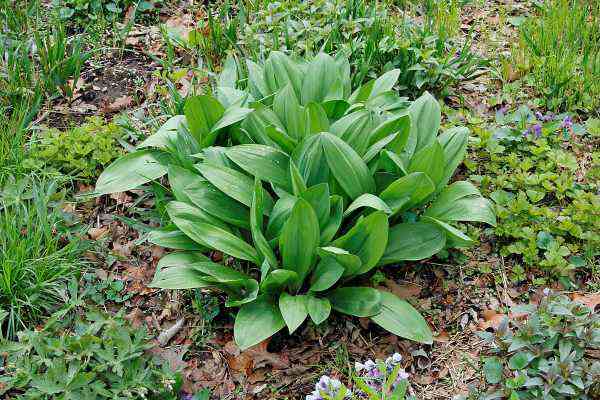Wild Leek
Wild leek are one of the earliest wild edible plants to emerge in spring. Historically, ramps were regarded as a spring tonic, and early settlers relied on their restorative qualities after a long winter.
Wild leek is a great as wild food plant, despite not being related to the leeks that are frequently grown in supermarkets. Just be sure to identify them appropriately. The leaves and the bulbs both taste deliciously of onion and garlic. We advise boiling them first since eating them raw can be a little rough on the stomach (much like eating a raw garlic clove).
The term “elephant garlic” refers to a genus of hundreds of distinct bulbous biennial blooming plants also called “wild leek,” “broadleaf wild leek,” or “wild leek.” It is a member of the amazing Amaryllidaceae family, which includes about 1600 distinct species spread across roughly 70 distinct genera.
The wild leek belongs to the Allium genus, making it a close relative of onions. One of the earliest plants to emerge in the spring is wild leeks. They are frequently observed in maple and mixed-wood forests and are highly regarded as a delicacy.
The leaves and bulbs are edible, raw or cooked. Depending on the geographic area you are foraging in, it is highly recommended to only harvest one leaf per plant due to the 7-year growth cycle.
Habitat
Ramp vegetable plants, or Allium tricoccum, are native to the appalachian mountains, part of Canada, west as Missouri and Minnesota, and south as North Carolina and Tennessee. Growing ramps are typically encountered in clusters in dense, damp deciduous forests. The ramp, a related plant to the onion, leek, and garlic plant, is another strong vegetable that is experiencing a resurgence in popularity.
Allium tricoccum is a North American species of wild onion widespread across eastern Canada.

Planting and Growing
They grow happily in the rich and moist shaded soil under hardwood (deciduous) trees. Although they may be slow to grow, they transplant very well and have a high success rate from seed (though the seed will lay dormant for 2 years before sprouting).
Ramps thrive in the natural during the longer days and warmer temperatures of early spring when the deciduous trees overhead have not yet begun to leaf out. The ramps become less visible in the scant light that illuminates the forest floor as the season goes on and the tree canopies grow.
The two main objectives of growing ramps in a backyard garden are to gather the fragrant leaves in the spring and to create the colony for future expansion. Early in the summer, the leaves die back, and then the flower stalks while the bulbs grow underground.
Be extremely cautious not to harm the roots or bulbs when starting with transplants or bulbs. To allow the plants to spread, put them at the same depth as in the pot and distance them 4 to 6 inches apart. Mulch the entire bed with something like crushed leaves or leaf mold after giving the plants plenty of water.
Soil
Try to choose a location for ramps in your yard that is as similar to their natural growing environment as you can. They frequently inhabit wet regions beneath deciduous trees. The soil should be well-draining and contain a sizable amount of organic materials. The pH of the soil should be nearly neutral, ideally in the range of 6.8 and 7.2.
Water
Despite liking constant precipitation, damp soils are not good for growing ramps. Ramps should thrive if nearby woodland plants like bloodroot, trillium, and trout lilies will also bloom. There is little space for error because they only actively grow for a brief time in the spring.
Light
Ramps are spring-flowering woodland plants, so they require protection from the intense heat and sun of the summer. Give them a position in the shade to partial shade if you can’t plant them on the border of woods, where they will be protected as the trees begin to leaf out.
Temperature
Ramps develop best at temperatures between 45 and 65 degrees Fahrenheit during the day and 42 to 58 degrees Fahrenheit at night. The ideal temperature for ramps is 54 degrees Fahrenheit during the day and drops to 46 degrees Fahrenheit at night. Ramps grow at humidity levels varying from about 5 percent in very late winter to over 60 percent at the end of May as native plants of northeastern U.S. hardwood forests.
Fertilizers
If the soil is rich in organic matter and has a pH that is neutral, ramps may not require any feeding. If your soil is deficient in calcium and magnesium, think about providing these nutrients first. They like soil that has relatively high levels of these nutrients.
Uses
Ramps are collected for their leaves and bulbs, which have a taste and perfume similar to spring onions. They were typically cooked in butter or animal fat with eggs and potatoes or included in soups and pancakes back in the day. Ramps were treasured by both early colonists and American Indians. After months without any fresh vegetables, they were a vital early spring food source and were regarded as a “tonic.” For later usage, ramps can also be pickled or dried.
In upscale restaurants today, they can be served sautéed in butter or olive oil. Ramps and their relatives have been employed as medicinal treatments for a variety of illnesses, and one of these traditional cures has been incorporated into contemporary medicine. Garlic and ramps were both frequently used to expel internal worms, and a concentrated variety is currently made commercially. Allicin is the scientific word for it; Allium is the collective noun for all onions, garlic, and ramps.
Companion Plants for Wild Leek
Companion plant suggestions include Trout lily, Dutchman’s breeches, wild geranium, hepatica, Mayapple, Solomon’s seal, bloodroot, and other spring flowers common in maple, basswood, and red and white oak woods.







Leave a Reply
You must be logged in to post a comment.